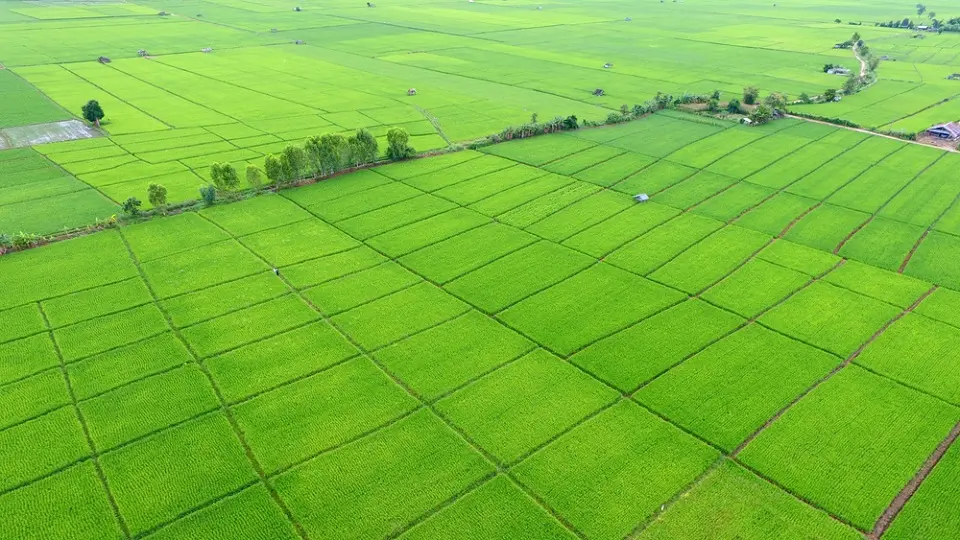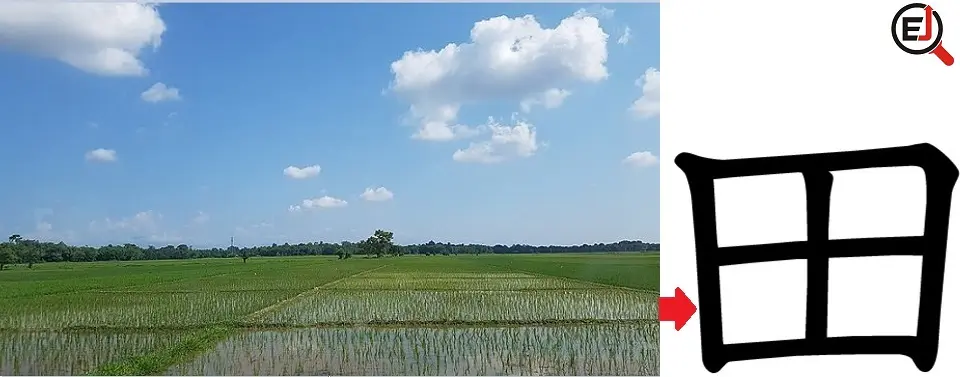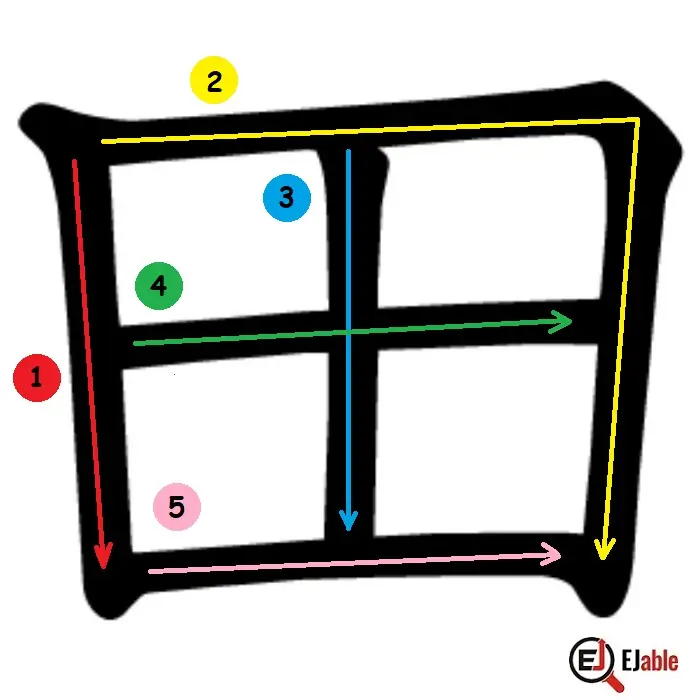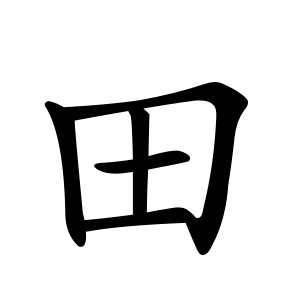Kanji for Paddy (Rice Field): 田 (Da)

田 is the kanji for “rice field” in Japanese.
The pronunciation of the Kanji 田 is “ta” (た) in its kun’yomi (Japanese reading) and “den” (デン) in its on’yomi (Chinese reading). The shape of this kanji is rather simple, and its shape has a clear origin. However, in some compounded words, the Japanese pronunciation changes to “da”.
A couple of words that most foreigners would know consisting of this Kanji are the two airports of Tokyo, namely Narita (成田) and Haneda (羽田).
The Kanji 田 is constructed with 5 strokes. This Kanji is a part of the JLPT N4 syllabus (please check the list of JLPT N4 kanji). In Japanese schools, this Kanji is taught in grade 1.
About Rice Fields (Paddy)


Rice fields are traditionally divided into sections for various practical reasons. This division is primarily related to the cultivation and management of the crop.
Rice cultivation requires a specific amount of water. Ensuring the specific amount for the rice plants is more manageable when the field is divided into sections or paddies. These sections allow for better water control. Water can be added or drained from individual sections as per the requirement. This is particularly useful in areas with uneven terrain.
Sectioning the field also makes it easier to manage different stages of growth, as one section can be planted or harvested while others are at different stages. This way, we way farmers can maintain a continuous planting, growing, and harvesting cycle.
Furthermore, dividing the fields into sections can help prevent the spread of diseases or pests that may affect the rice plants. If an infestation or disease occurs in one section, it may be possible to isolate that section and prevent the problem from spreading to the entire field.
Origin and How to Remember 田 as Rice Field Kanji


As mentioned above, rice fields have sections to manage a specific amount of water. Therefore, the kanji character 田 (ta or da), symbolizes the practical division of rice fields into smaller sections. The lines represent the borders of different plots within the field, forming a cross-like pattern that is pretty easily recognizable even in the modern character.
Stroke Order for the Kanji 田
The following illustrations show the stroke order to write the rice field kanji 田:




田 as a Radical and Component in other Kanji Characters
The kanji for “rice field,” 田 (ta), is also a radical in Japanese kanji. When it appears as a radical, it’s known as “たでん” (taden) and is often associated with fields, farming, or concepts related to land and agriculture.
Overall, Kanji 田 appears as a radical or as a component in 831 Kanji characters, including 84 Jōyō Kanji.
Examples of 田 as a Radical and Component
Following are some examples of kanji where 田 (paddy) appears as a radical:
- 畑 (はたけ, hatake): Cultivated field (specifically for crops other than rice).
- 畔 (あぜ, aze): Ridge between rice fields.
- 留 (りゅう, ryū): Detain, stop, keep.
- 略 (りゃく, ryaku): Abbreviation, outline.
- 番 (ばん, ban): Number, order.
- 画 (が, ga): Drawing, painting; to plan.
- 異 (い, i): Different, unusual.
- 畳 (じょう, jō): Tatami mat.
- 畜 (ちく, chiku): Livestock.
- 當 (とう, tō): To hit the target, to be in.
- 畏 (い, i): Fear, awe.
- 畢 (ひつ, hitsu): Finish, complete.
- 異 (い, i): Different, unusual.
- 畸 (き, ki): Odd, irregular.
- 畹 (えん, en): Small field.
These examples show the use of 田 as a radical in various kanji, often with a meaning related to land, agriculture, or fields. Some characters might have extended meanings that are metaphorically or historically linked to the concept of fields or land.
Rice Field (Ta or Den) Kanji in Compounded Words
The kanji for “rice field,” 田 (た, ta or でん, den), is commonly used in various compound words in Japanese.
90 Japanese words begin with the Kanji 田, and it appears in 228 words.
Examples of Kanji 田 in Compounded Kanji Characters
Following are the examples where Kanji for power or strength appears in Japanese compounded Kanji characters:
- 田園 (でんえん, den’en): Rural, countryside, fields.
- 田植え (たうえ, taue): Rice planting.
- 水田 (すいでん, suiden): Irrigated rice field.
- 田舎 (いなか, inaka): Countryside, rural area.
- 田畑 (たはた, tahata): Fields and rice paddies.
- 田中 (たなか, Tanaka): A common Japanese surname, literally means “in the rice field.”
- 稲田 (いなだ, inada): Rice field (specifically for growing rice).
- 田作り (たづくり, tadzukuri) – Rice cultivation.
- 田んぼ (たんぼ, tanbo): Rice field (colloquial term).
- 田代 (たしろ, Tashiro): Another Japanese surname, meaning “rice field representative.”
- 田舎 (いなか, inaka): Countryside
- 田舎者 (いなかもの, inakamono): Country person, someone from the countryside.
- 田地 (でんち, denchi): Farmland, fields.
- 田分 (たぶん, tabun): Division of rice fields.
- 田楽 (でんがく, dengaku): A traditional Japanese dish, also a form of traditional entertainment.
- 田貫 (たぬき, Tanuki): Another Japanese surname literally means “through the rice field.”
These compound words illustrate the versatility of 田 in the Japanese language, reflecting its cultural significance not only in agriculture but also in place names, surnames, and even in colloquial expressions.
A Note About the Pronunciation
The reading “ta” is typically used when the kanji character is read by itself or in certain words. For example, in the word 田んぼ (tanbo), which means “rice paddy,” 田 is read as “ta.”
The reading “da” is typically when the character is part of a compound word, particularly when it comes after another character that ends with the ‘n’ sound. This happens because of a process called rendaku, which causes the initial consonant of the second element of a compound to become voiced. This is why 田 is read as “da” in the word 田園 (den’en), meaning “countryside,” or 稲田 (inada), meaning “rice field.”
Cultural and Historical Significance:
Agricultural Roots:
Rice farming has been central to Japanese culture and society for centuries. The kanji 田, representing rice fields, symbolizes the agricultural roots of Japan and the importance of rice as a staple food. It’s deeply integrated with the country’s history, economy, and cultural traditions.
Symbol of Sustenance and Prosperity:
Rice fields, as depicted by 田, are more than just agricultural spaces; they are symbols of sustenance, fertility, and prosperity. The success of rice cultivation was and still is crucial to the population’s well-being.
Seasonal Connections:
Rice planting and harvesting are closely connected to Japanese seasonal festivals and rituals. For example, the Otaue Rice Planting Festival, a traditional event held in various regions, celebrates the rice planting season with dances and ceremonies meant to pray for a good harvest.
Landscape Aesthetics:
The aesthetic of rice fields, a common sight in rural Japan, has inspired countless artists, poets, and filmmakers. The tranquil scenery of 田 fields, especially when flooded with water, reflecting the sky, is a design you can often see in Japanese art and literature.
Socio-Cultural Metaphors:
In Japanese culture, rice fields sometimes metaphorically represent organization, structure, and communal labor. The well-ordered and meticulously maintained 田 fields reflect the values of cooperation, harmony, and respect for nature.
Urban vs. Rural Identity:
The contrast between the urban landscape (都市, toshi) and rural rice fields (田園, den’en) reflects a significant aspect of Japanese identity and societal structure. This contrast often appears in cultural narratives and media, highlighting the shift from traditional to modern lifestyles.
Place Names and Surnames:
Many Japanese place names and surnames are derived from or include 田, indicating historical connections to rice cultivation or proximity to rice fields. It’s a testament to how agriculture has shaped settlement patterns and identities.
Do check other Kanji characters on the page “How to Remember Kanji“.


A long-term ex-pat in Japan, Himanshu comes with an IT background in SAP consulting, IT Business Development, and then running the country operations of an IT consulting multinational. Himanshu is the co-founder and Managing Director of ReachExt K.K. and EJable.com. He is also an Advisory Board Member of a Silicon Valley AI/IoT startup.

